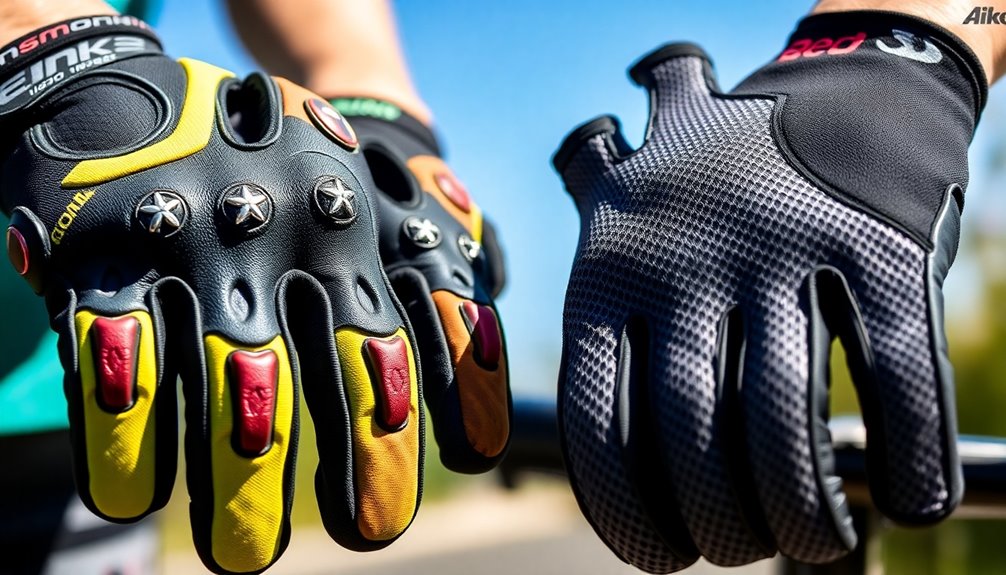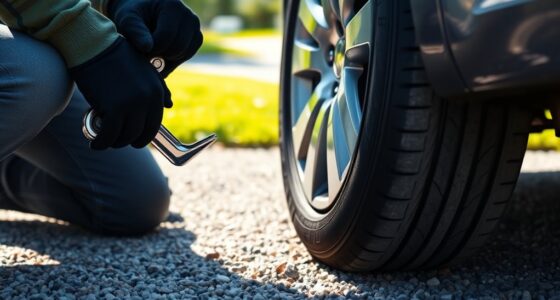When choosing cycling gloves, look for key features tailored to your riding style. If you're mountain biking, opt for full-fingered gloves with shock-absorbing padding and durable materials for grip and protection. For road cycling, go for lightweight, fingerless gloves that enhance breathability and provide cushioning. Don't forget weather resistance and special features like touchscreen compatibility. Each type has unique characteristics that can greatly impact your comfort and performance. There's more to explore to find the perfect fit!
Key Takeaways
- Mountain bike gloves should have full-finger coverage for maximum protection against abrasions during falls, while road gloves often feature a fingerless design for breathability.
- Look for shock-absorbing padding in mountain bike gloves for rough terrain, whereas road gloves prioritize cushioning for comfort on long rides.
- Choose mountain bike gloves with silicone grip patterns to enhance control on uneven surfaces; road gloves use smoother palms for aerodynamics and comfort.
- Opt for durable materials like leather in road gloves for grip, while mountain bike gloves should use tougher fabrics like polyurethane for rugged conditions.
- Consider weather resistance: mountain bike gloves may include waterproof features, while road gloves focus on breathability and light rain resistance for comfort during rides.
Importance of Cycling Gloves
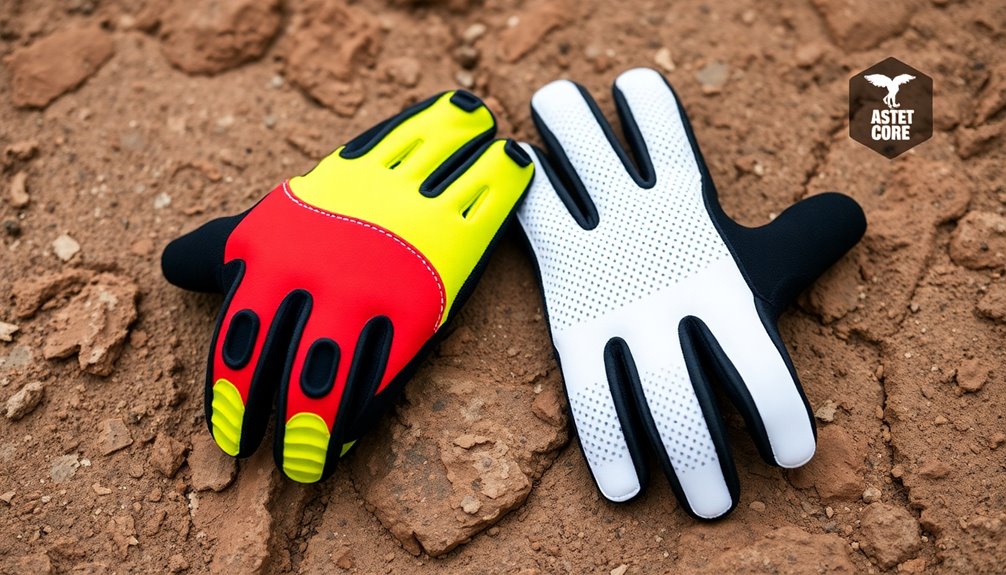
Cycling gloves play an essential role in enhancing your riding experience, especially during long rides. They provide important padding on the palm that reduces hand fatigue and absorbs vibrations, making your journey much more comfortable.
Not only do these gloves offer protection against chafing and blisters, but they also shield your hands from abrasions in case of falls, which is critical for mountain bikers.
Additionally, gloves improve grip and control on the handlebars, particularly in wet or sweaty conditions, boosting your overall safety. They act as a barrier against harsh weather, preventing numbness in colder climates.
Choosing the right pair of gloves can greatly enhance your performance by improving dexterity when operating brake and shift levers.
Key Differences Between Mountain Bike and Road Cycling Gloves
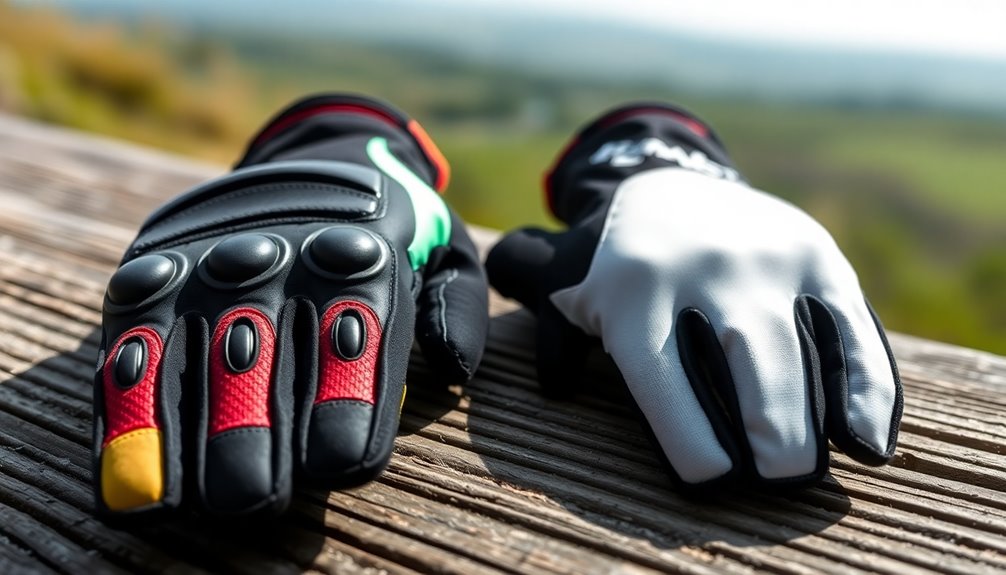
When comparing mountain bike and road cycling gloves, it's clear that they serve different purposes tailored to specific riding conditions.
Mountain biking gloves are typically full-fingered, offering maximum hand protection against scrapes and impacts. In contrast, road cycling gloves often feature a fingerless design, enhancing breathability and freedom of movement.
Mountain biking gloves provide full-fingered protection, while road cycling gloves prioritize breathability and mobility with their fingerless design.
Padding in mountain bike gloves includes shock-absorbing features for vibrations from rough terrain, while road gloves focus on cushioning for comfort during long rides.
Grip enhancement is essential in mountain biking gloves, incorporating silicone patterns for traction in wet conditions, whereas road gloves have smoother palms for better aerodynamics.
Ultimately, each glove type is designed to meet the unique demands of its respective discipline.
Material Considerations for Durability and Breathability
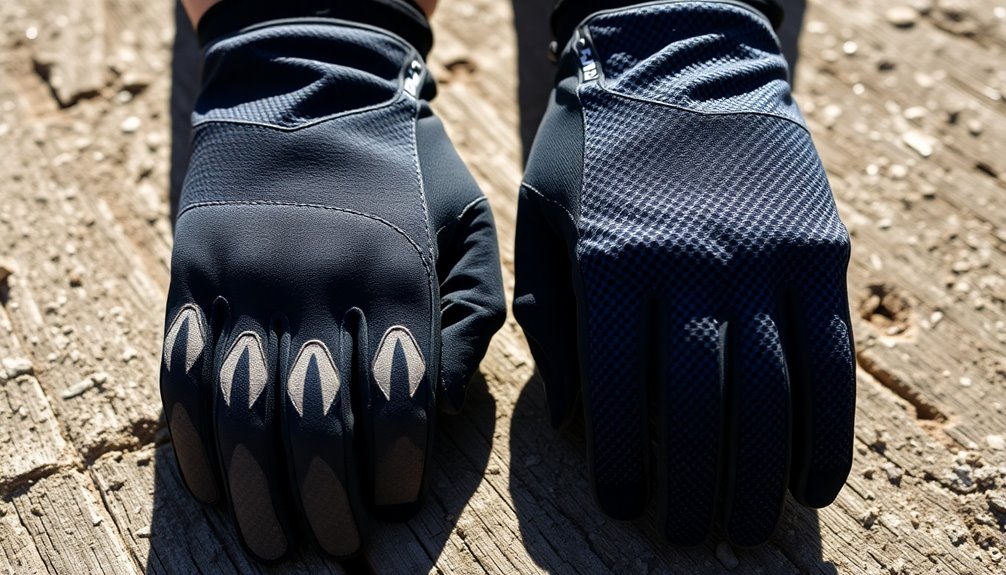
While choosing the right gloves for your ride, it's essential to take into account the materials that balance durability and breathability.
Mountain bike gloves often feature durable materials like leather and polyurethane, designed to withstand rough terrain and falls. In contrast, road cycling gloves prioritize breathable fabrics such as polyester and mesh, enhancing comfort during long rides.
Both types may include weather-resistant materials like nylon and neoprene, though these can reduce breathability, so selecting the right fit is important. If you're riding in colder conditions, consider insulation properties like fleece or Primaloft.
Remember, there's a trade-off: mountain biking gloves focus on protection, while road gloves aim to minimize weight and maximize airflow.
Choose wisely for your riding style!
Grip and Padding Features
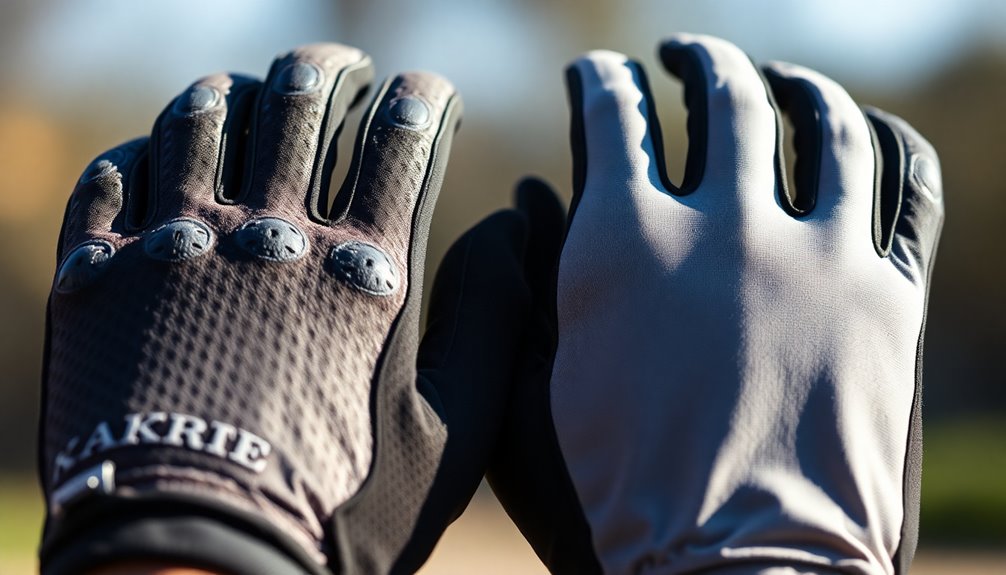
Grip and padding features are essential for enhancing your riding experience, whether you're tackling rugged trails or cruising on the open road.
Mountain bike gloves often come with silicone patterns on the palms and fingers, giving you better control on rough terrains. In contrast, road cycling gloves use soft gel or foam padding to absorb vibrations, minimizing hand fatigue during long rides.
The palm material in road gloves is typically durable, like leather, for peak grip, while mountain gloves feature textures to prevent slippage in wet conditions.
Shock-absorbing padding in mountain bike gloves protects high-impact areas, whereas road gloves focus on lightweight padding for comfort.
A well-fitted glove enhances grip and dexterity, allowing you to confidently operate brake and shift levers.
Waterproofing and Weather Resistance
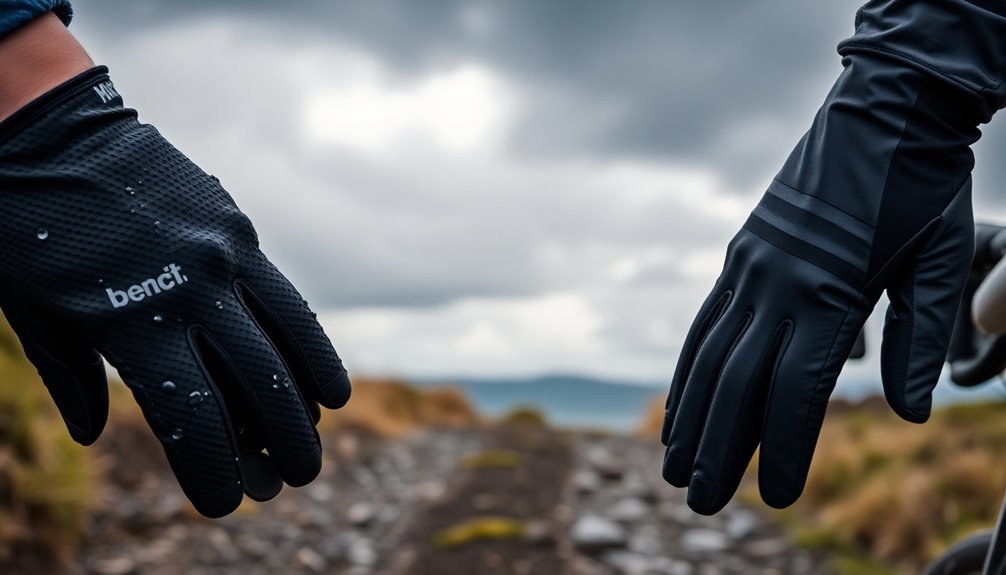
Choosing the right gloves for your ride means considering waterproofing and weather resistance, especially if you plan to tackle unpredictable conditions.
For mountain biking, prioritize durability and weather resistance by selecting gloves made from robust materials like nylon and neoprene. These materials can withstand the wet and rugged trails you might encounter.
Waterproof gloves, featuring Gore-Tex or rubber components, effectively block water while still offering some breathability. Look for gloves with seam sealing to prevent water seepage during extended rain exposure.
On the other hand, road cycling gloves focus more on breathability, incorporating weather-resistant fabrics to shield against wind and light rain.
Always remember, the trade-off between waterproofing and breathability plays a critical role in your comfort and performance.
Fit and Comfort for Optimal Performance

When choosing gloves for cycling, a snug wrist closure is key to keeping dirt and water out while ensuring comfort.
You'll want to find the right balance between padding and flexibility, so your hands can move naturally without restriction.
Proper sizing for your hand shape matters too, as it helps prevent slippage and enhances your overall grip on the handlebars.
Snug Wrist Closure Importance
A snug wrist closure is essential for enhancing your performance and comfort while cycling. It keeps dirt, debris, and water out, ensuring a pleasant ride.
With a secure wrist closure, you'll feel more in control of your handlebars, allowing for better maneuverability. Adjustable closures like Velcro straps or elastic cuffs offer a customizable fit, accommodating different wrist sizes and preferences.
- Keeps gloves in place without restricting movement
- Promotes moisture management by reducing sweat accumulation
- Provides additional protection during falls
- Enhances overall glove performance for long rides
Investing in gloves with snug wrist closures not only improves comfort but also safeguards you against potential injuries.
Padding and Flexibility Balance
Finding the right balance between padding and flexibility in cycling gloves is essential for your comfort and performance. You want gloves that offer sufficient gel padding to absorb vibrations without compromising dexterity.
For road cycling, softer foam or gel padding enhances comfort, while mountain bike gloves often use thicker padding for extra protection against impacts. The snug fit is vital; it minimizes excess material that can interfere with movement and grip on the handlebars.
Flexibility should be a priority, allowing your hands to move naturally while still providing adequate protection. Choose gloves that maintain a natural hand position to prevent discomfort or restricted circulation during long rides.
Ultimately, the right padding and flexibility balance will elevate your cycling experience.
Sizing for Hand Shape
Achieving the right balance of padding and flexibility in cycling gloves sets the stage for understanding sizing for hand shape. Proper sizing is essential; gloves should fit snugly to reduce excess material that can interfere with dexterity while riding.
Here are some tips to guarantee you find the right size:
- Measure the circumference around the widest part of your hand.
- Check sizing charts from manufacturers to confirm your size.
- Consider different hand shapes, like wider palms or longer fingers.
- Try on gloves and flex your fingers to guarantee natural movement.
Additional Protection for Mountain Bike Gloves

When traversing rough trails, having the right mountain bike gloves can make a significant difference in your ride.
These gloves are designed with additional protection in mind, featuring extra padding on the palms and fingers for shock absorption during bumpy terrain. Many models include protective armor made of molded plastic or carbon fiber, safeguarding your hands from injuries in case of falls.
The back of the gloves often uses durable materials to shield against branches and rocks, essential on challenging trails. Enhanced grip is another key feature, with silicone patterns applied to the palms and fingers, ensuring you maintain control over your handlebars in slippery conditions.
Plus, some gloves incorporate breathable materials for moisture management while still providing necessary protection.
Ventilation and Temperature Management
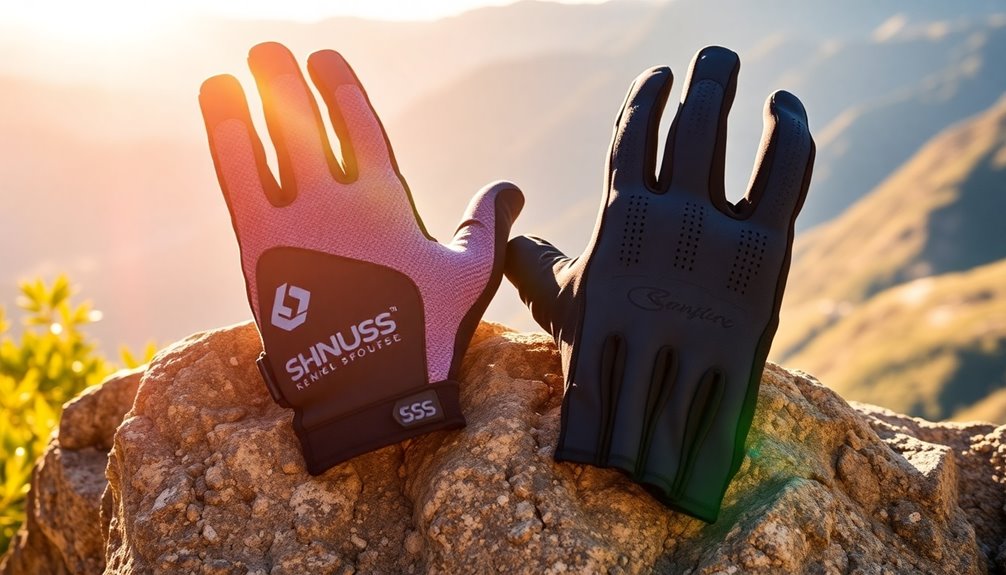
When choosing gloves for your rides, pay attention to the materials used and their moisture-wicking properties.
Breathable fabrics can keep your hands cool and comfortable, especially during those intense climbs or long miles on the road.
Plus, adjustable ventilation features can help you customize airflow to match the weather conditions.
Breathable Fabrics Selection
Choosing the right breathable fabrics for your cycling gloves can make a world of difference in your comfort and performance on the bike.
Whether you're mountain biking or hitting the road, selecting gloves with the right ventilation and temperature management is key.
- Look for mesh panels in mountain bike gloves to enhance airflow.
- Opt for lightweight polyester in road cycling gloves for a snug fit.
- Make certain that breathable fabrics prevent overheating during those hot rides.
- Test for moisture-wicking materials to keep your hands dry.
Moisture-Wicking Properties
Moisture-wicking properties in cycling gloves are essential for keeping your hands dry and comfortable during long rides. These gloves draw sweat away from your skin, reducing the risk of blisters and enhancing overall comfort.
Made from breathable fabrics like mesh and lightweight polyester, they allow for better airflow, which aids in temperature regulation during intense biking sessions. Maintaining effective moisture management is critical for maintaining your grip on the handlebars; sweaty hands can lead to slippage and decreased control, especially in mountain biking where precision is essential.
High-quality gloves often feature perforated palms or mesh panels, boosting moisture-wicking capabilities and ensuring peak hand temperature in various weather conditions.
Choose wisely, and enjoy your ride!
Adjustable Ventilation Features
While enjoying a thrilling ride, having adjustable ventilation features in your cycling gloves can make all the difference in comfort.
These features enhance breathability, allowing for improved airflow during intense rides, especially in warm weather. Whether you're mountain biking or road cycling, consider how these elements can elevate your experience:
- Mesh panels or ventilation holes for ideal airflow
- Moisture-wicking materials to keep your hands dry
- Lightweight, breathable fabrics to reduce overheating
- Adjustable cuffs and closures for customized ventilation
Effective temperature management is essential, so look for gloves with insulated materials for cooler rides that still offer breathability.
With the right gloves, you can enjoy your ride without worrying about discomfort.
Special Features: Touchscreen Compatibility and More

Have you ever found yourself struggling to use your phone while out on a ride? A good pair of cycling gloves with touchscreen compatibility can make a world of difference.
Look for gloves that incorporate special conductive materials on the fingertips, allowing you to interact with your smartphone or GPS without removing them. Reinforced fingertips are another great feature, adding durability in high-wear areas while still offering touchscreen functionality.
Extra features like microfiber nose wipes on the thumbs can also come in handy for both mountain and road cyclists.
When selecting your gloves, verify they fit snugly around the wrist. This not only enhances comfort but also provides easy access to your devices, helping you absorb shocks of the ride seamlessly.
Choosing the Right Gloves Based on Riding Style
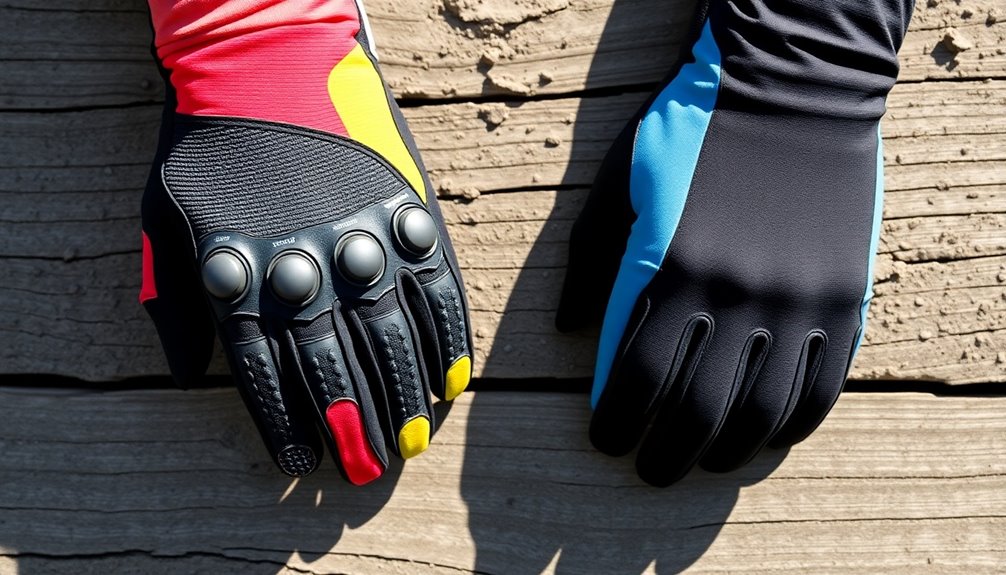
Selecting the right gloves for your riding style can greatly enhance your overall experience on the bike.
Whether you're hitting the trails or cruising the pavement, choosing the right cycling gloves is essential.
- Mountain biking gloves often feature a full-finger design for maximum protection.
- Look for extra padding and durable materials to withstand rough terrain.
In contrast, road cycling gloves usually have a fingerless design for breathability and dexterity.
Consider weather conditions: mountain biking gloves should be weather-resistant, while road gloves need to be lightweight and water-resistant for long rides.
Frequently Asked Questions
How to Choose a Cycling Glove?
When you're choosing cycling gloves, start by considering the type of riding you'll do.
Measure your hand's circumference for the right fit—snug but comfortable.
Look for features that suit your needs, like padding for shock absorption or grip texture.
Don't forget about the weather; breathable materials work well in heat, while insulated options are best for cold.
Finally, adjustable closures and moisture-wicking properties can enhance your overall riding experience.
What Are the Benefits of Mountain Bike Gloves?
You might think that any glove will do for mountain biking, but that's not the case.
Mountain bike gloves offer essential benefits like full-finger protection, which shields your hands from falls and rough terrain. They often have padded backs to absorb impacts and textured palms for a secure grip, even in wet conditions.
Plus, breathable materials keep your hands comfortable during intense rides, reducing fatigue and enhancing your overall biking experience.
What Is the Difference Between Road Bike and Mountain Bike Posture?
When you ride a road bike, you lean forward into an aerodynamic position, which can strain your hands and wrists.
In contrast, mountain biking keeps you more upright, giving you better control over uneven terrain. This posture lets you shift your weight effectively, distributing it across your arms and hands.
The difference in body position influences how you handle each bike, affecting your overall comfort and performance during rides.
Do Cycling Gloves Make a Difference?
Absolutely, cycling gloves greatly enhance your ride.
Comfort and control come from their cushioned construction, reducing fatigue and improving grip as you tackle tough terrains. You'll find they shield your hands from scrapes and blisters, making every journey more enjoyable.
Plus, the moisture-wicking materials keep your palms dry, preventing those pesky blisters.
Conclusion
In the grand tapestry of cycling, choosing the right gloves is more than just a matter of comfort; it's about enhancing your riding experience. Each type of glove brings its own unique flair, catering to the distinct demands of mountain biking and road cycling. So, as you commence on your next adventure, remember to select gloves that not only protect your hands but also embrace your style, ensuring every ride feels just right. Happy cycling!
